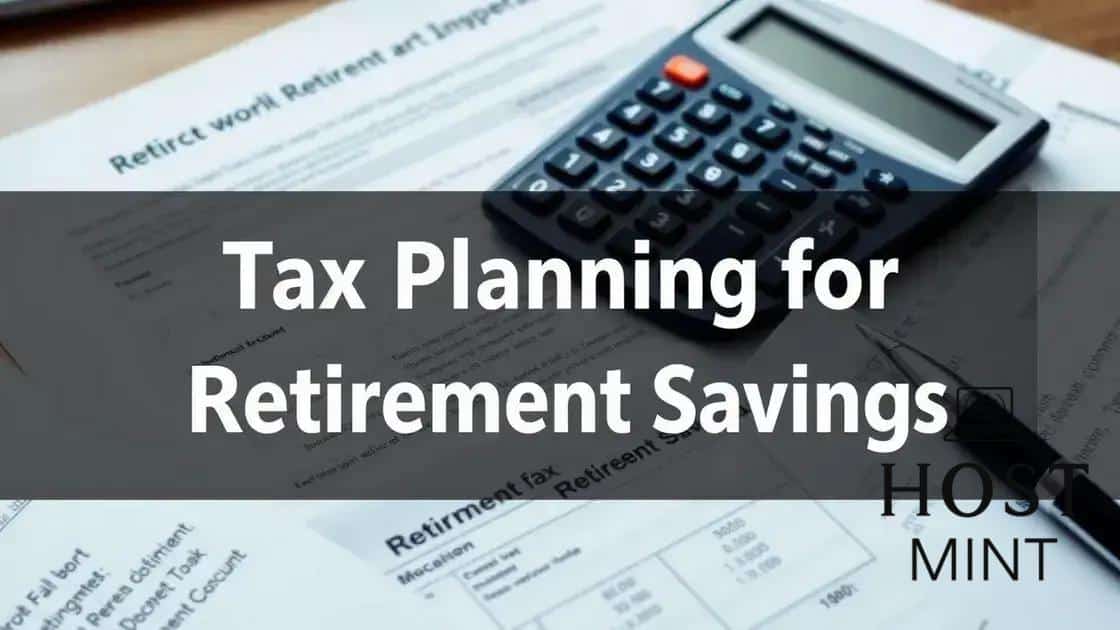Best retirement plans for self-employed workers to consider

The best retirement plans for self-employed workers include options like Solo 401(k)s, SEP IRAs, and Roth IRAs, which provide various tax benefits and flexibility in contributions to secure your financial future.
Thinking about your future? The best retirement plans for self-employed workers can safeguard your financial well-being. Let’s dive into what options you have and how they work!
Understanding retirement plans for self-employed
Understanding retirement plans for self-employed individuals is crucial for securing a comfortable future. In this section, we will explore different types of plans and what makes them beneficial.
Types of Retirement Plans
For self-employed workers, several effective retirement plans can help you save for the future. Here are a few popular options:
- Solo 401(k): This plan works well for those without employees. It allows for higher contribution limits compared to other plans, helping you maximize savings.
- SEP IRA: A Simplified Employee Pension (SEP) is easy to set up and offers a flexible contribution based on your income.
- Traditional IRA: This option allows for tax-deferred growth on your investments until retirement.
- Roth IRA: While contributions are made with after-tax dollars, withdrawals in retirement are tax-free.
When selecting a retirement plan, consider factors like your income stability, age, and retirement goals. Each option has unique benefits and requires different contributions and withdrawals strategies.
Factors to Consider
As you weigh your retirement options, think about how much you can realistically contribute each year. Would you prefer tax-deferred savings or tax-free withdrawals in retirement? Additionally, consider your expected retirement age. The sooner you start saving, the more you can benefit from compound interest.
Choosing the right retirement plan for your needs can feel overwhelming. But educating yourself on retirement plans for self-employed workers will empower you to make informed decisions. Always remember that every small contribution counts toward your future security.
Top retirement plans available
When it comes to planning for your future, knowing the top retirement plans available can guide you toward making the best choices. Each plan has unique features that can suit different needs.
1. Solo 401(k)
The Solo 401(k) is an excellent option for self-employed individuals. It allows for significant contribution limits and the ability to make both employee and employer contributions. This plan also offers a loan option, which can be beneficial if you need quick access to funds.
2. SEP IRA
A Simplified Employee Pension (SEP) IRA is another popular choice. It’s easy to set up and maintain, with minimal paperwork. This plan allows you to contribute up to 25% of your compensation, which is great for those with variable incomes.
3. Simple IRA
The Simple IRA is designed for smaller businesses and sole proprietors. It includes lower contribution limits than the Solo 401(k) but features mandatory employer contributions, making it a good choice for those who might want to attract employees.
4. Traditional and Roth IRAs
Traditional and Roth IRAs are also solid options for retirement planning. The Traditional IRA offers tax-deductible contributions, while the Roth IRA allows for tax-free withdrawals during retirement. Depending on your financial situation, either can be a beneficial addition to your retirement strategy.
Each of these plans has its own advantages and disadvantages. Analyzing your specific situation can help you determine which is the best fit for your financial goals.
5. Review Your Options Regularly
It’s essential to review your retirement plans annually. This ensures you remain on track with your retirement savings. By staying informed about changes in the retirement landscape, you can adjust your strategy to maximize your savings and benefits.
How to choose the right retirement plan
Choosing the right retirement plan is essential for self-employed individuals. The right choice can help maximize your savings and provide financial security in your retirement years.
Evaluate Your Financial Situation
Your first step should be assessing your current financial status. Consider your income, expenses, and savings goals. Understanding your financial picture will help you identify which retirement plan aligns with your needs.
Understand Your Retirement Goals
Next, think about your retirement goals. Do you want to retire early? Or are you looking to accumulate funds for a later retirement? Knowing your timeline will influence which plan you choose. Shorter timelines may require different strategies than long-term planning.
- Early retirement: Consider plans with higher contribution limits.
- Later retirement: Focus on plans that offer tax benefits when withdrawing funds.
- Income stability: Ensure your chosen plan allows flexibility in contributions.
Another vital aspect to consider is your investment comfort level. Some plans allow you to choose your investments, while others may involve less control. If you’re unsure about how to invest, look for plans that provide managed investment options.
Check Contribution Limits and Tax Benefits
Each retirement plan has different contribution limits and tax implications. Understanding these variations is crucial for optimizing your savings. Make sure to review:
- Annual contribution limits: See which plan allows you to contribute the most.
- Tax deductions: Some plans let you deduct contributions from your taxable income.
- Tax-free growth: Options like Roth IRAs allow your savings to grow without tax implications upon withdrawal.
Don’t forget about fees associated with each plan. Some may have higher administrative costs or investment fees that could eat into your savings over time. Compare the costs before making your final decision.
Evaluating all these factors can seem overwhelming, but taking a systematic approach will help you find the plan that suits your unique situation. Remember that this decision is an important step towards a secure financial future.
Tax advantages of retirement accounts

Understanding the tax advantages of retirement accounts can greatly influence your overall savings strategy. By utilizing these accounts, you can maximize your funds while minimizing your tax burden.
Tax-Deferred Growth
One of the main benefits is the tax-deferred growth on your investments. With accounts like a Traditional IRA or a Solo 401(k), your contributions are made before taxes, which means you won’t owe taxes on any dividends or capital gains until withdrawal. This allows your money to grow faster, as you can reinvest what would have otherwise gone to taxes.
Tax-Deductible Contributions
Many retirement accounts offer tax-deductible contributions. This feature reduces your taxable income for the year, lowering your overall tax bill. For instance, if you contribute to a Traditional IRA, you may deduct that contribution from your taxable income, making it an effective way to save on taxes while saving for retirement.
- Contribution Limits: Be aware of annual limits. For 2023, you can contribute up to $6,500 ($7,500 if you’re age 50 or older) to a Traditional IRA.
- Employer Contributions: If you’re self-employed and use a Solo 401(k), you can make contributions both as an employee and employer, amplifying your savings.
- Plan-Specific Rules: Each account has different rules on tax benefits; always check the specifics to maximize your savings.
Tax-free withdrawals are another critical consideration. For accounts like the Roth IRA, after age 59½, you can withdraw your contributions and earnings tax-free, provided you’ve held the account for at least five years. This can significantly enhance your retirement income, especially in your later years.
When planning your retirement, remember that understanding these tax benefits can shape your financial strategy. Knowing when and how to take advantage of withdrawals can impact your retirement lifestyle. By making informed decisions, you’re setting yourself up for a more secure financial future.
Tips for managing retirement savings effectively
Managing retirement savings effectively is essential for achieving long-term financial security. With the right strategies, you can ensure that your savings grow over time and align with your retirement goals.
Set Clear Goals
The first step is to set clear retirement savings goals. Determine how much money you will need for retirement based on your expected lifestyle. This will help you establish a savings target to work towards.
Create a Budget
Creating a budget is vital for managing your savings. By tracking your income and expenses, you can identify areas to cut costs and increase your savings. Allocate a specific percentage of your income to your retirement accounts each month. This disciplined approach ensures consistent contributions.
- Automate Savings: Set up automatic transfers to your retirement account to make saving seamless.
- Adjust Regularly: Revisit your budget periodically to accommodate changes in income or expenses.
- Emergency Fund: Maintain an emergency fund to avoid dipping into retirement savings during unforeseen circumstances.
It’s also essential to review your investment portfolio regularly. The market changes, and your asset allocation should reflect your risk tolerance and retirement timeline. Consider consulting with a financial advisor to ensure your investments are on track.
Diversify Your Investments
Diversification is key to reducing risk in your investment portfolio. By spreading your investments across various asset classes, such as stocks, bonds, and real estate, you can mitigate potential losses during market downturns. A well-diversified portfolio has a better chance of weathering market fluctuations.
Consistency plays a significant role in wealth accumulation. Regular contributions, even small ones, can lead to substantial growth over time. Take advantage of any employer matching contributions to maximize your retirement savings.
Finally, stay informed about changes in retirement laws and accounts. Education is a powerful tool in effective retirement management. Knowing your options allows you to make better decisions about where to put your money.
FAQ – Frequently Asked Questions about Retirement Plans for Self-Employed Workers
What is a Solo 401(k)?
A Solo 401(k) is a retirement savings plan designed for self-employed individuals and business owners with no employees. It offers high contribution limits and tax advantages.
How can I maximize my retirement savings?
You can maximize your retirement savings by setting clear goals, automating your contributions, diversifying your investments, and taking advantage of employer matching if available.
What are the tax benefits of having a retirement account?
Retirement accounts like Traditional IRAs allow tax-deferred growth on investments, while Roth IRAs provide tax-free withdrawals in retirement. Additionally, contributions may be tax-deductible.
How often should I review my retirement plan?
You should review your retirement plan at least once a year or whenever there are significant changes in your financial situation, such as changes in income, expenses, or life events.






